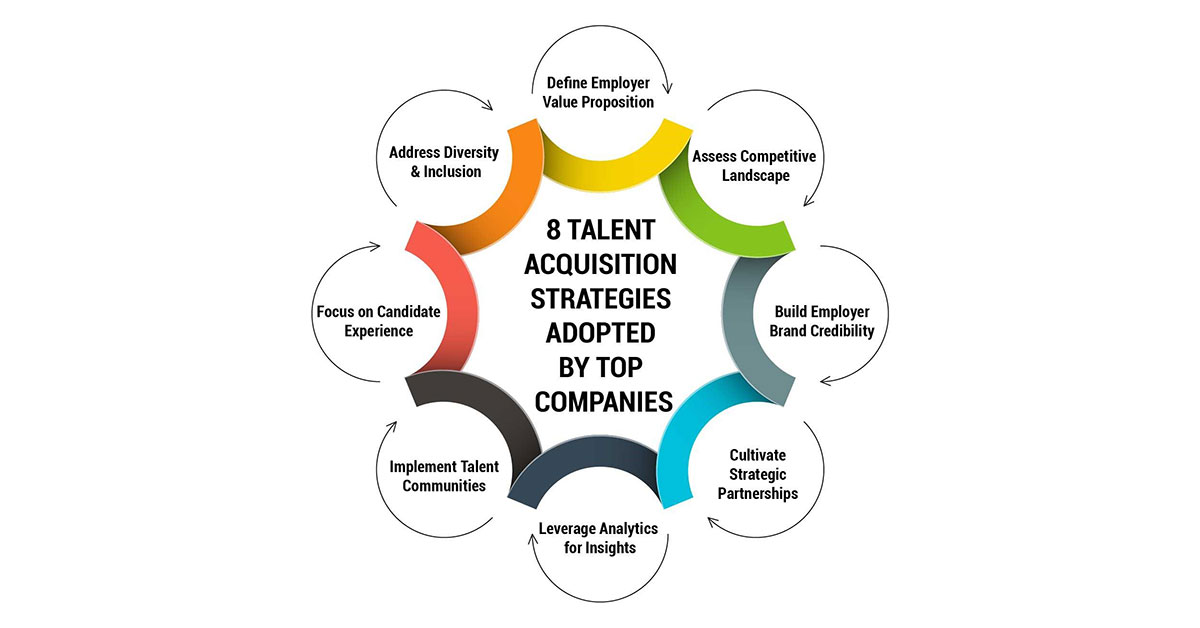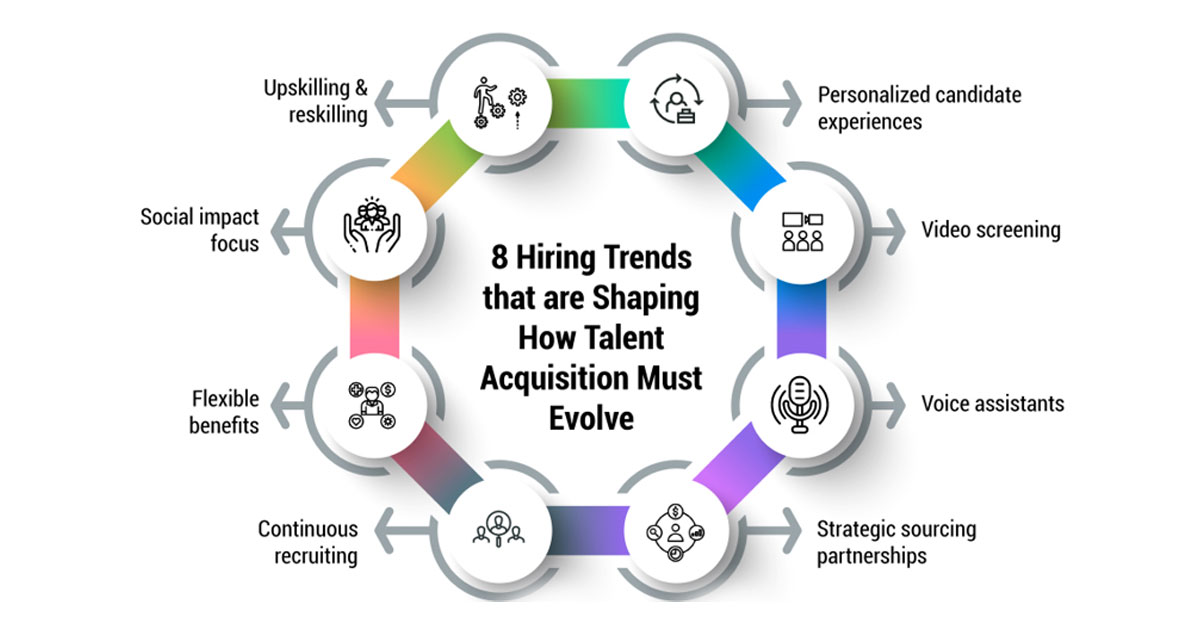Talent Acquisition: Identifying and Recruiting Top Performers
July 12, 2024

In today’s highly competitive business environment, acquiring talented individuals is crucial for organizational success. Standing out from competitors and delivering outstanding results hinges on having the right people in place. This is where talent acquisition comes into play.
Talent acquisition refers to the overall process of sourcing, recruiting, and hiring the best candidates for open roles. Going beyond traditional recruitment, it aims to attract, select, and onboard individuals with the skills, experience, and qualities needed to advance business goals. With the war for talent fiercer than ever, talent acquisition has become a strategic priority for forward-thinking companies.
This article explores what talent acquisition entails, why it matters, and how to excel at it. We’ll cover everything from defining your target talent profile to utilizing different sourcing methods and optimizing the hiring process. Our objective is to equip HR and talent leaders with best practices for identifying and recruiting top performers in their industry.
What is Talent Acquisition?
At its core, talent acquisition involves three key stages:
-
Attracting Candidates - This first stage is all about promoting your organization as an employer of choice and raising awareness of open positions. The goal is to attract a large, qualified pool of potential hires.
-
Recruiting Candidates - The next step is evaluating applicants and selecting top candidates to move forward in the hiring process. Screening resumes and conducting interviews and assessments are all part of recruitment.
-
Onboarding New Hires - For those who are ultimately hired, the onboarding stage comes in. The aim here is to help new employees assimilate, become productive quickly, and feel welcomed as new members of the team.
While these stages follow a linear process, talent acquisition is an ongoing cycle rather than a one-off activity. Top companies never stop attracting, recruiting, and developing talent, even when not actively hiring. They continuously cultivate prospective candidates and strengthen their employer brand.
Why is Talent Acquisition Important?
There are several compelling reasons why having a strategic talent management approach to talent acquisition matters more than ever:
-
Shrinking Talent Pool - With low unemployment rates and a growing skills gap, competition for in-demand skills is fierce. Those with sought-after expertise have their pick of opportunities. Proactive acquisition efforts are needed to attract scarce talent.
-
Employee Expectations are Evolving - Younger generations entering the workforce have different priorities and care deeply about company culture, values, perks, and opportunities for growth. Employer branding must adapt to changing expectations.
-
Technology is Disrupting Industries - Digital transformation is happening at breakneck speed across all sectors. To keep up and stay ahead of disruption, businesses require multi-skilled talent with flexible, future-proof abilities.
-
Talent Impacts Growth - Simply put, the right employees are transformational. Strong performance innovation and game-changing ideas stem from who you hire. Talented individuals are key to achieving aggressive growth targets.
-
Competition for Talent is Intense - Other employers, especially startups, are aggressively courting in-demand skills. You have to work diligently to attract candidates and convince them to join your team over alternatives.
In this new order, an ad-hoc, passive approach to sourcing talent will not suffice. Strategic acquisition anchored by data and best practices is now mission-critical for operational and financial success.
Talent Acquisition vs Recruitment
While often used interchangeably, talent acquisition is a broader term that encompasses recruitment as one part of the process. Recruitment refers specifically to sourcing candidates and encouraging them to apply, whereas talent acquisition manages the entire hiring lifecycle from sourcing through onboarding. Some key differences:
-
Scope - Recruitment focuses on filling current openings, while acquisition has a broader remit of identifying and cultivating potential candidates for future needs as well.
-
Outlook - Recruitment tends to be transactional and event-driven. Acquisition adopts a long-term, continuous mindset to build a pipeline and employer reputation.
-
Capabilities - In addition to sourcing and selection, acquisition develops a holistic understanding of required skills through techniques like competency modeling and predictive analytics.
-
Branding - Promoting the organization as an ‘employer of choice’ falls under the acquisition’s ambit. It shapes employer value propositions to target different talent segments.
-
Metrics - Recruitment metrics usually revolve around fill rates and time-to-hire. The acquisition also tracks the quality of hires, retention rates, and impact on business goals.
In essence, talent acquisition applies strategic foresight and a Total Talent Management approach encompassing everything from sourcing to onboarding, retention to development of people. It’s an end-to-end process ensuring the long-term fulfillment of human capital needs.
Talent Acquisition Process
The standardized talent acquisition process can be summarized in seven stages:

-
Job Analysis - Define open roles along with requisite skills, experience, and qualifications via a detailed job description.
-
Sourcing Candidates - Leverage both passive and active sourcing methods to build a talent pool, like job boards, referrals, campus hiring, etc.
-
Recruitment - Screen and shortlist suitable profiles through resume screening, phone screens, and one-way video interviews for initial assessment.
-
Evaluating Candidates - Conduct behavioral and technical assessments, test scores, case studies, and formal/video interviews to identify best fits.
-
Making an Offer - Negotiate compensation package and sign offer letter upon candidate’s acceptance of terms.
-
Onboarding - Welcome and induct new hires and ensure compliance and productivity through a structured onboarding program.
-
Continuous Feedback - Administer pulse surveys and 1:1s with managers and stay connected to new joiners for feedback during probation and beyond.
This fluid process is customized based on job level, location, and other factors. Tech enablement through ATS/CRM streamlines screening while maintaining a personal touch. Global acquisitions may have country-specific deviations, too.
Talent Acquisition Methods
To optimize outreach and broaden the talent pool, acquirers leverage a blend of sourcing tactics. Here are some of the most widely adopted methods:
-
Referrals - Leveraging employee social networks via referral programs remains a top channel. It has the highest conversion rates.
-
Job Boards/Aggregators - Sites like Indeed, LinkedIn, and Monster still drive a large volume of applicants cost-effectively.
-
Company Website - Ensure job openings are prominently displayed under the ‘Careers’ page and regularly refreshed.
-
Recruitment Process Outsourcing (RPO) - For high-volume needs, many leverage specialized RPO partners’ outsourced sourcing teams.
-
Campus/University Recruiting - Tap student communities and recent graduates via campus events, internship programs, projects, etc.
-
Social Media - Leverage professional networks, post openings on LinkedIn and Twitter, and run targeted social ads.
-
Virtual & In-person Career Events - Host/participate in conferences, meetups, hackathons, and job fairs to interact face-to-face.
-
Active Sourcing - Tap networks and directly scout profiles through tools that identify passive candidates.
Diversity in methods ensures a steady flow of both passive and active candidates across touchpoints.
Talent Acquisition Strategies
Beyond executing the acquisition process, strategic planning and tailored initiatives are required to excel in the talent race. Here are some impactful strategies adopted by top companies:

-
Define Employer Value Proposition - Craft a compelling narrative highlighting what makes your organization a great place to work, supported by a strong culture, growth prospects, etc.
-
Assess Competitive Landscape - Benchmark talent programs against closest competitors and disruptors. Understand how they attract top talent. Adapt leading practices as needed.
-
Build Employer Brand Credibility - Leverage employee advocacy and reviews on sites like Glassdoor to establish authenticity as an employer and engage candidates.
-
Cultivate Strategic Partnerships - Collaborate with universities, staffing firms, and consultancies to gain referrals and visibility at key touch points like campus communities and talent pools.
-
Leverage Analytics for Insights - Analyze metrics on talent flows, source performance, etc., to optimize acquisition spending while improving quality, diversity, and time-to-fill.
-
Implement Talent Communities - Nurture ongoing relationships by engaging past candidates and alumni in networking forums and content hubs to stay connected as potential hires.
-
Focus on Candidate Experience - Streamline and personalize every step from application to onboarding via tech like chatbots and videos seeking feedback to continuously enhance the candidate journey.
-
Address Diversity & Inclusion - Build a diverse workforce through intentional outreach and inclusive marketing, reflecting your commitment to equal opportunities.
A well-crafted talent acquisition strategy underpinned by the right tools, data, and programs sets the stage for sustainable competitive advantage in sourcing top performers.
Talent Acquisition Metrics
To optimize efforts, talent teams must track relevant KPIs that provide visibility into what’s working well and areas needing improvement:
-
Time to hire - Measuring average days to fill roles. Quick hires indicate smooth processes.
-
Application conversion rate - Ratio of candidates interviewed to total applicants. Identifies the most effective sourcing channels.
-
Offer acceptance rate - Percentage of candidates making it through the full process that accepts an offer letter.
-
Retention rate - Percentage of new hires that stay past the probationary period of typically 3-6 months.
-
Referral ratio - Percentage of hires attributed to employee referral programs. Determines program effectiveness.
-
Diversity metrics - Tracking gender, ethnicity, disability, and veteran demographics of applicants and hires.
-
Resource utilization - Time spent per hire by different team members and vendors helping gauge capacity.
Tracking leading and lagging metrics allows recruitment teams to demonstrate value added and optimize roadblocks.
Talent Acquisition Trends
Several hiring trends are shaping how talent acquisition must evolve:

-
Personalized candidate experiences - Leveraging AI to deliver customized, engaging interactions across touchpoints.
-
Video screening - Video interviewing and assessments are used to shortlist efficiently without geographical constraints.
-
Voice assistants - Chatbots and virtual assistants answering candidate queries 24/7.
-
Strategic sourcing partnerships - Tie-ups between large employers and specialized diversity recruiters.
-
Continuous recruiting - Always keep the pipeline full through constant sourcing vs. episodic hiring.
-
Flexible benefits - Remote options, paid leave policies, growth opportunities attracting millennial talent.
-
Social impact focus - Candidates prefer employers demonstrating strong environmental/social values.
-
Upskilling & reskilling - Lifelong learning culture through ongoing training, helping retain the workforce.
Adapting rapidly to emerging trends ensures talent acquisition stays relevant and compelling to candidates.
Conclusion
In today’s talent market disruptions, those companies that can effectively source, assess, and sign top skills through strategic acquisition practices will significantly advantage themselves for long-term success.
Leveraging the elements above, like employer branding, workforce mapping, assessment tools, onboarding best practices, and continuous process enhancements, provides the framework for organizations to consistently bring the best talent on board.
With a dedicated acquisition approach, any company can proactively build high-performing teams and future-proof its workforce, directly powering productivity gains, innovations, and sustainable competitive advantages.



